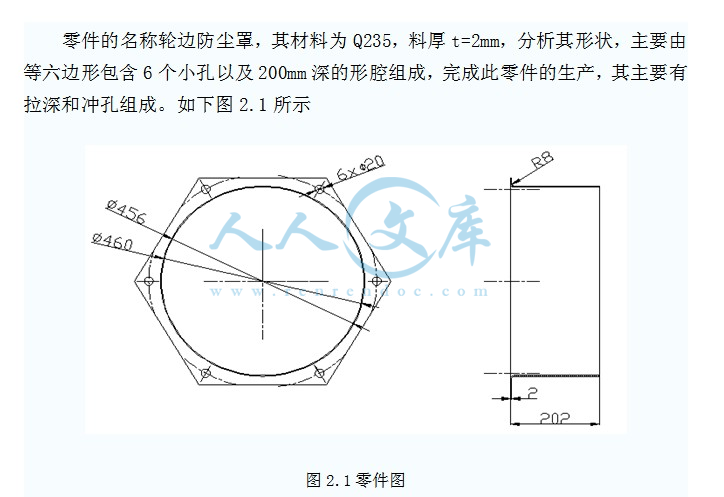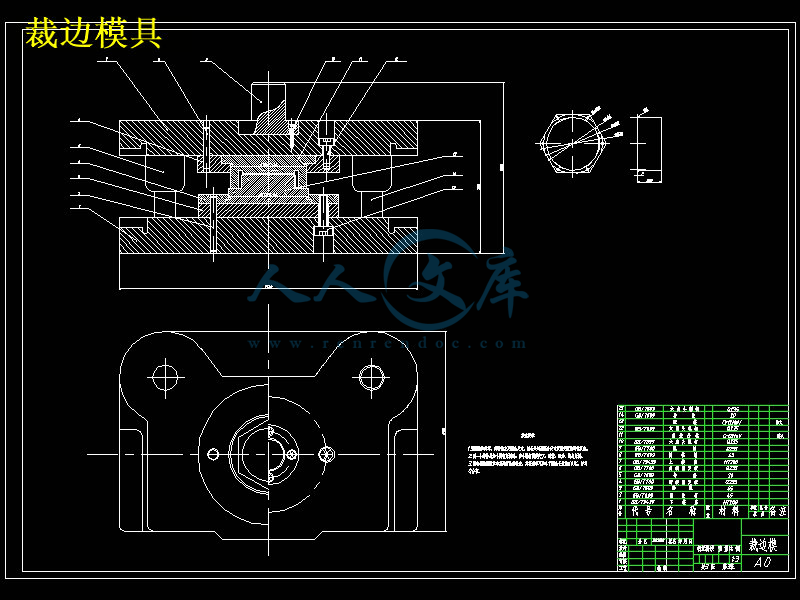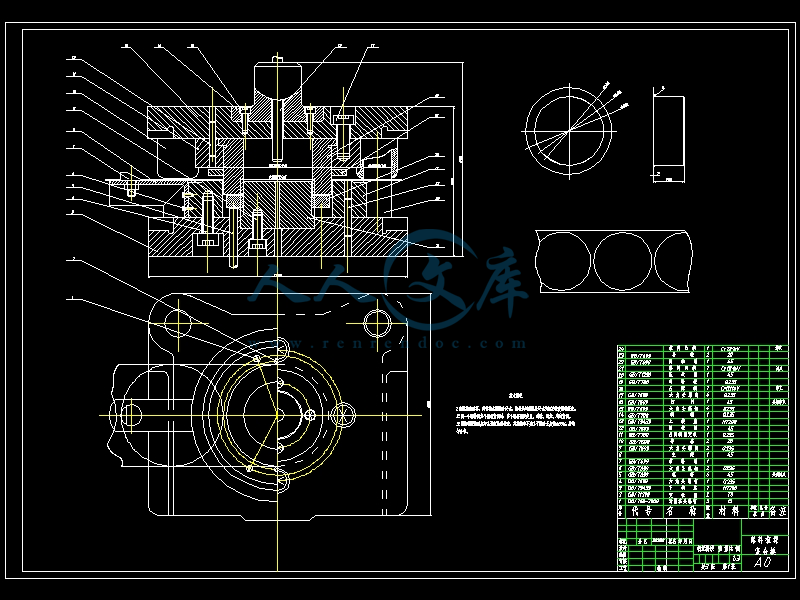摘要
本设计是汽车配件轮边防尘罩冲压模具设计,分析工件结构,其主要包括落料;拉深;冲孔;修边。首先确定工艺方案,选择一个比较合理的设计方案。其次,根据设计方案确定一共需要多少副模具来完成轮边防尘罩的生产。在本次设计中,采用三副模具来生产该工件。第一副是落料拉深,第二副是冲孔,第三副是修边。每副模具的设计中都包括凸凹模刃口尺寸的确定和结构形式,定位零件的设计,卸料与推件装置的设计,以及其它辅助零件的设计。在模具的设计过程中首先要考虑零件工作的合理性,然后考虑零件的经济性。
关键词:工艺分析;方案确定;落料拉深;修边冲孔
Blanking Die Design of Dust Cover of The Wheel Rim
Abstract?
This design is blanking die design of dust cover of the automobile wheel rim, including blank; deep drawing; punch; modification, through the structure analysis of work piece.?First, determination of technological arrangement is for choosing the best alternatives in this design. Second, according to the proposal of this design, we should decide that how many moulds are used to complete production of dust cover of the automobile wheel rim. In this design, three moulds are applied in this process. The compound for blanking and deep drawing is used in the first process. Punch are practiced in second process. Similarly, the third mould is used for modification in the last process. One each of these moulds design is consisted of the sizes of punch and die cutting edge, location components, tripping and ejection equipment, and assistant structure parts. In the process of mould design, we should consider the reasonableness of working parts, and then take the cost of parts production.
Key words: Technological analysis; Determination of arrangements; Blank and deep drawing; Modification and punch
目 录
1 绪 论 1
1.1冲压与冷冲模概念 1
1.2模具工业在当今市场的发展状况和前景 1
1.3 模具在现代工业中的地位 2
1.4 冲压工艺的种类 2
1.5 冲压行业阻力和障碍与突破 3
2 冲压件的工艺过程 5
2.1 分析零件的冲压工艺性 5
2.1.1 分析其冲裁的工艺性 5
2.1.2 分析其拉深的工艺性 6
2.1.3 材料的性能 9
2.2 冲压件的工艺方案的拟定 9
2.3 毛坯尺寸的确定 10
3 排样和搭边 11
3.1冲裁件的材料利用率 11
3.2 排样和搭边 12
4 压力机的选择 14
4.1 落料拉深 14
4.1.1 压力中心 14
4.1.2压边力、拉深力的计算 15
4.1.3 压力机的选择 16
4.2 修边冲孔 17
4.2.1冲裁力 17
4.2.2 推件力 18
4.2.3 卸料力 18
4.2.4 压力机的选择? 18
5 落料拉深模具设计 19
5.1 模具类型 19
5.2 模具结构和工作原理 19
5.3 主要零件的结构与设计 20
5.3.1 工作零件 20
5.3.2 定位零件 24
5.3.3 压料、卸料及出件零件 25
5.3.4? 辅助结构零件 25
5.3.5工作零件的设计 26
5.3.6其他零件的设计 28
6 冲孔模的设计 29
6.1 模具基本结构与工作原理 29
6.2 模具的主要零件设计 29
6.2.1 工作零件的设计 29
6.2.2 其它零件的设计 32
7 裁边模设计 34
7.1 模具基本结构和工作原理 34
7.2 模具主要零件的设计 34
7.2.1 工作零件的设计 34
7.2.2 其它零件的设计 35
8 模具加工工艺分析 37
8.1 模具材料 37
8.2 模具加工工艺 37
总 结 38
参考文献 39
致 谢 40
毕业设计(论文)知识产权声明 41
毕业设计(论文)独创性声明 42
1 绪 论
1.1冲压与冷冲模概念
冲压是在室温下,利用安装在压力机上的模具对材料施加压力,使其产生分离或塑性变形,从而获得所需零件的一种压力加工方法。
在冲压加工中,将材料加工成零件的一种特殊工艺装备,称为冲压模具。冲模在现实冲压加工中是必不可少的工艺装备,与冲压件“一摸一样”的关系,若没有符合要求的冲模,就不能生产出合格的冲压件;没有先进的冲模,先进的冲压成型工艺就无法实现。在冲压零件的生产中,合理的冲压成形工艺、先进的模具、高效的冲压设备是必不可少的三要素。冲模在种类繁多的模具中占有十分重要的地位,是工业生产中应用最为广泛的模具,从产量上看,它占了模具总产量的30%以上,从产值上看,它占了模具总产值的50%左右。
冲压加工与其他加工方法相比,无论在技术方面,还是在经济方面,都具有许多独特的优点。生产的制件所表现出来的高精度、高复杂程度、高一致性、高生产率和低消耗,是其他加工制造方法所不能比拟的。但需要指出的是,由于进行冲压成形加工必须具备相应的模具,而模具是技术密集型产品,其制造属单件小批量生产,具有难加工、精度高、技术要求高、生产成本高(占产品成本的10%~30%)等特点。所以,只有在冲压零件生产批量大的情况下,冲压成形加工的优点才能充分体现,从而获得好的经济效益。







 川公网安备: 51019002004831号
川公网安备: 51019002004831号